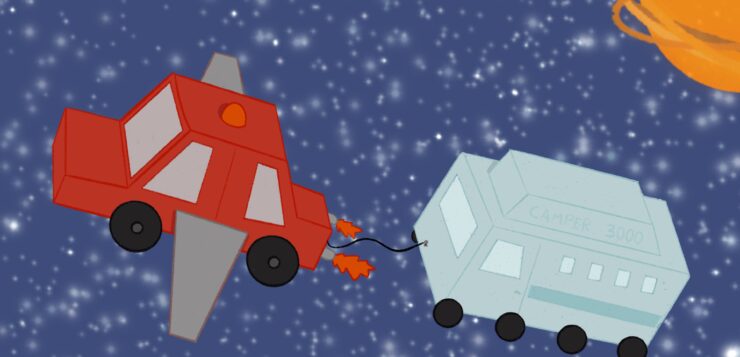Greetings, interstellar holidaymaker, and congratulations on your first step toward the most memorable and awe-inspiring excursion you’ll ever take. This guide is the perfect way for the rookie astro-vacationer to tackle the cosmos and muddy their boots on alien planets. And where better to start than our own backyard? The Solar System. Buckle in, check your oxygen tanks, make sure you’ve brought enough packed lunches, and let’s blast off!
Note: This guide includes only major bodies in the system that are possible to land on. The gas giants aren’t included, as upon your landing attempt you’d fall through and be crushed by their internal pressures – but they make for amazing fly-bys! Check out the rings of Saturn, the Spot of Jupiter, and the marvellous colours of Uranus and Neptune.
The Moon
‘One small step for man, one giant leap for mankind.’ You may be inclined to disagree with Armstrong as you wait out the three-day trip to our closest destination, but where better to start than the most significant stellar body in our solar system, tied only with the Sun! Luckily, we can visit the Moon without being atomised by the 5505°C surface temperatures of our star. That being said, the Moon is no picnic either. You’ll need to pack all-weather clothing, as temperatures can vary from 127°C in the day to -173°C at night. You’ll have to stay inside your spacesuit and stick with pre-prepared meals, but rest assured the stunning views of the landscape will make up for it! Of best interest are the ancient impact craters. You may be lucky enough to find ice on the poles, or scientific expeditions like Apollo 11. The most incredible view, of course, will be Earth. As Russian cosmonaut Alexei Leonov put it, ‘The Earth was small, light blue, and so touchingly alone, our home that must be defended like a holy relic. The Earth was absolutely round. I believe I never knew what the word round meant until I saw Earth from space.‘
Mars
The God of War, the Red Planet – Mars has had a place in the public consciousness for a very long time. The ancient Greeks and east-Asian cultures both referred to it as ‘fiery’, but despite it’s red surface, Mars is extremely cold. This is another planet that you’ll need to pack warmer clothes for, as it can plummet to -143°C (although temperatures can reach 35°C at the height of summer.) But don’t be fooled, summer is also storm season. These dust storms are deadly, as can be seen in The Martian, and will blow away your lodgings with their 100 mph winds! You need to plan out your visit in advance, which you’ll have plenty of time to do over your seven month journey. Upon landing safely, there will be many choices for sightseeing. Whilst the canals are an optical illusion, there is plenty to see, such as the icy poles or Valles Marines, the largest canyon in the solar system that runs the length of New York to Los Angeles. For the hiker, there’s Olympus Mons, a colossal volcano the size of Poland and three times the height of Mt. Everest. After that, you’ll definitely be in need of a breather!
Venus
As the brightest point in the sky (excluding the Sun) Venus has always had a place in human mythology. Common features ascribed include purity, bringing of light, and beauty. While this sounds lovely, the brightness of the planet is due to its dense and reflective atmosphere composed of carbon dioxide, nitrogen and sulphuric acid. Yikes. The pressure density is 93 times that of Earth’s, resulting in a greenhouse effect that makes the temperature 462°C. Do not visit the surface. Colour pictures from the Soviet-era show a hazy yellow wasteland, and while you may be determined, the hellish conditions will certainly dissuade you. The upper atmosphere of Venus is conversely quite pleasant with rolling clouds abound. They make the 97 day travel time worth it.
Mercury
The closest planet to the Sun and fastest planet in the solar system, it’s no wonder this planet is named after the messenger god. The surface of Mercury is similar to that of the Moon, with many impact craters that are adorably named after famous poets and artists. On your travels, you can visit Dr Seuss, Shakespeare and the Brontës – assuming you don’t mind them being rocks! Mercury is also the best place to get a good look at the sun, although you’ll need sun cream and sunglasses, as temperatures can reach 427°C during the day. I strongly advise sticking to the cooler areas. Due to its close proximity to the Sun, Mercury is a victim of solar flares, which are devastating to tourists. It’s theorised that the planet is so small (just larger than the Moon) because the sun has stripped away its mantle, leaving a denser core behind. Make sure you check the weather forecast during your 147 day journey, as you don’t want to be blasted into space!
And thus ends this guide that will hopefully inspire you to take your first steps into the unknown. There are multiple bodies in our solar system not covered in this article, like the moons of Jupiter and Saturn, and many others within the Asteroid Belt. With this guide to get you started, you can get out there and forge your adventure amongst the stars. Just remember – pack for a long trip!




